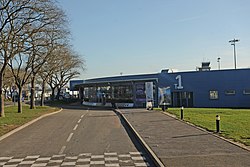Paris Beauvais
|
Beauvais–Tillé Airport Aéroport de Beauvais-Tillé Advanced Landing Ground (ALG) A-61/B-42 |
|||||||||||||||
|---|---|---|---|---|---|---|---|---|---|---|---|---|---|---|---|
 |
|||||||||||||||
| Summary | |||||||||||||||
| Airport type | Public | ||||||||||||||
| Operator | Chambre de Commerce let d'Industrie (CCI) de l'Oise | ||||||||||||||
| Serves | Beauvais, France | ||||||||||||||
| Location | Tillé | ||||||||||||||
| Elevation AMSL | 359 ft / 109 m | ||||||||||||||
| Coordinates | 49°27′16″N 02°06′46″E / 49.45444°N 2.11278°ECoordinates: 49°27′16″N 02°06′46″E / 49.45444°N 2.11278°E | ||||||||||||||
| Website | aeroportparisbeauvais.com | ||||||||||||||
| Map | |||||||||||||||
| Location of airport in Picardy region | |||||||||||||||
| Runways | |||||||||||||||
|
|||||||||||||||
| Statistics (2016) | |||||||||||||||
|
|||||||||||||||
|
Sources: French AIP
|
|||||||||||||||
| Passengers | 3,997,856 |
|---|---|
| Aircraft movements | 34,905 |
Beauvais–Tillé Airport (French: Aéroport de Beauvais-Tillé) (IATA: BVA, ICAO: LFOB), branded as Paris-Beauvais Airport, is an international airport near the city of Beauvais in the commune of Tillé in France. It is the tenth busiest airport in France, handling 3,997,856 passengers in 2016, and is mostly used by charter and low-cost airlines.
Despite its brand name, the airport is located in the Picardy region and 85 km (53 mi) north-northwest of Paris.
This airport was built in the 1930s and seized by the Germans in June 1940 during the Battle of France. Beauvais was used as a Luftwaffe military airfield during the occupation. Known units assigned (all from Luftflotte 3, Fliegerkorps IV):
The initial German use of the airport was as a bomber base. kg 76 and SKG 1 both took part in the Battle of Britain. kg 76 was reduced to 19 out of 29 serviceable machines by 18 August 1940. kg 76 raided London on 7 and 15 September 1940.
With the Luftwaffe switching to night attacks on England, the badly damaged units at Beauvais were replaced by a series of He 111 and Ju 88A units that carried out anti-shipping missions (KG 26, KG 77) and night bombing missions over England (KG 4, KG 54, KG 6).
The increasing number and frequency of USAAF Eighth Air Force Boeing B-17 Flying Fortress and Consolidated B-24 Liberator daylight heavy bomber raids over occupied Europe and Germany made the Luftwaffe move out the bomber units and assign day interceptor fighter units to attack the American bombers as part of the Defense of the Reich. After the invasion of Normandy, elements of JG 1 were moved to France and were tasked with providing air support to the German army, along with their normal air defense role against Allied bombers.
...
Wikipedia

